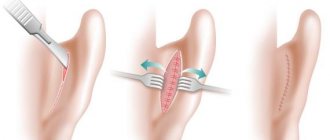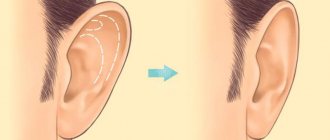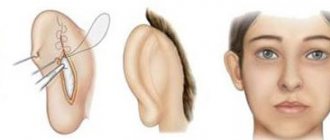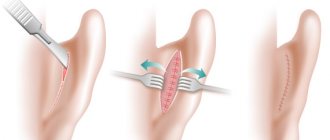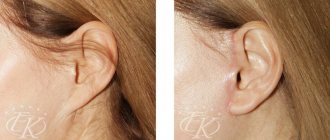Types of otoplasty
Otoplasty can be aesthetic or reconstructive.
Aesthetic, as a rule, implies a minor intervention: during the operation, the surgeon eliminates the external defect by changing the location, size or shape of the auricle. The operation takes from 30 minutes to 2 hours.
Reconstructive otoplasty is aimed at complete or partial restoration of the lost/absent auricle (a graft (cartilage material) from the patient’s rib is used as a reconstructive material). The period of reconstructive correction is divided into several stages - the formation of ear cartilage as the basis of the future ear, the formation of the auricle itself and the final aesthetic correction. The total duration of all manipulations is about a year.
The operation is performed both under general anesthesia (for example, for children) and under local anesthesia (for adults). The surgical technique is chosen by the surgeon based on the task. Auricular plastic surgery as an aesthetic operation does not affect hearing function in any way.
Operation stages
Before the otoplasty procedure, the surgeon holds a consultation with the patient, during which he explains all the features of the upcoming operation. The complexity of performing ear surgery depends on the defects requiring correction. In some cases (for example, earlobe plastic surgery), the duration of the procedure does not exceed 1 hour and does not require general anesthesia.
Main stages of otoplasty:
- the patient is given local/general anesthesia;
- the surgeon makes an incision on the back of the ear;
- the epithelium is separated from the cartilage;
- eliminate the defect (removal of cartilage tissue or other);
- a suture is applied (absorbable threads are used in plastic surgery for otoplasty);
- applying a bandage.
Wearing a bandage is mandatory for several days until the surgeon is sure that the wound has healed and the ear itself has taken the desired shape.
Reconstructive otoplasty usually requires transplantation of cartilage tissue. Cartilage from the patient's rib is used for transplantation. If the patient does not have an auricle, then skin stretching methods are used to create a “pocket” into which an ear artificially created by specialists will subsequently be inserted.
Correction of protruding ears in adults and children
Correcting protruding ears is one of the most common reasons for visiting a plastic surgeon. Prominent ears are not considered a medical pathology, so ear plastic surgery in this case is purely aesthetic.
Severe protruding ears can become the basis of psychological trauma and the cause of ridicule from others. An important feature of plastic surgery for protruding ears is the minimal level of intervention during surgery. The guaranteed safety of the operation allows otoplasty to be performed on a child.
Ear plastic surgery in children at EMC is performed from the age of 7, when the auricles are almost completely formed. The healing process goes quite quickly, the ears after otoplasty look natural and do not bother the child, after the healing process is completed the child will not even remember about the operation. Even upon closer inspection, no one will notice the small strip of cosmetic seam behind the auricle.
Cost of otoplasty
The Correct Clinic has been providing otoplasty services for many years. To have ear plastic surgery in Moscow at our center means to be confident in the result.
You can find out how much ear plastic surgery costs on the clinic’s website or by contacting our consultants by phone. All prices are indicated in the price list on the website. However, it is possible to determine exactly what the price for ear plastic surgery will be only after a consultation, during which the surgeon will determine the type of correction, method and complexity of the operation.
Our clinic uses only modern otoplasty methods. We are confident in the quality of work of plastic surgeons, so we guarantee the results of ear plastic surgery.
Correction of ear asymmetry
Asymmetry of the ears is quite common. If the patient considers the asymmetry to be too noticeable, then the most effective solution would be to perform otoplasty, correcting the proportionality of the ears.
If the patient is dissatisfied with the shape of only one ear, then, depending on the professional opinion of the surgeon and the desire of the patient, otoplasty can be performed on both one and two ears - to achieve maximum symmetry.
Plastic surgery is also performed for congenital hypertrophy of the earlobes (disproportion between the earlobes and the auricle), a rare but also common problem.
Otoplasty for children
Many parents are against plastic surgery in childhood. However, otoplasty is often a necessity that saves the child not only from peer criticism, but also subsequent problems with confidence and self-actualization.
Ear surgery is recommended between the ages of 8 and 14 years. During this period, the cartilage tissue is denser, but still quite elastic, which facilitates the surgeon’s work and speeds up the further recovery process.
In our clinic, otoplasty is performed on pediatric patients under general anesthesia. This is explained by the fact that it is difficult for children to maintain one position for 1–2 hours, and the operation can cause fear in the child and affect his mental state. In adolescence, surgery is performed under local anesthesia. Rehabilitation in children takes no more than 4 months.
Microtia
Microtia is underdevelopment or absence of the ear. Microtia can be either unilateral or bilateral.
The degree of microtia can vary - from the presence of small congenital defects (too narrow or absent external auditory canal, disproportion of one ear to the other) to a rudimentary ear (absence of the ear canal and eardrum). The complete absence of the auricle is called anotia.
Reconstructive ear otoplasty for microtia allows you to recreate the normal shape and size of the auricle, including the formation of a cartilaginous frame and ear block. After correction of the shape of the auricle, we can also talk about the possibility of restoring hearing function.
EMC employs a team of specialists unique in their professional skills (otorhinolaryngologists, audiologist, audiologist-hearing prosthetist, ENT surgeons), which allows us to use the most innovative methods of hearing restoration, including hearing aids using modern hearing prostheses.
Who is not recommended to undergo ear surgery?
Any operation has a number of contraindications. Despite the fact that otoplasty involves correction of only the outer part of the ear without making changes to the functionality of the hearing organ, there are a number of contraindications.
Ear plastic surgery is not performed on patients with diseases and pathological conditions:
- oncology (including benign forms, during chemotherapy);
- hemophilia;
- all types of hepatitis;
- HIV and AIDS;
- diseases of the endocrine system;
- drug addiction;
- a number of mental pathologies.
Women are not recommended to undergo otoplasty during pregnancy, menstruation and lactation.
Ear surgery after injury
Reconstructive ear surgery is necessary in cases where most of the tissue has been lost as a result of injury. As with microtia, reconstructive otoplasty can restore the normal shape and size of the ear after injury.
Earlobe surgery successfully solves the problem of earlobe correction after wearing so-called “tunnels” and heavy massive jewelry. As a result of wearing such accessories, the lobe becomes deformed, sags, and a fairly large gap remains at the place of the decoration.
Otoplasty allows you to correct this aesthetic defect: correction of the lobe in this case involves suturing the resulting cavities and holes with microscopic cosmetic sutures. Earlobe plastic surgery allows you to get the optimal result - the scar is practically invisible, and the earlobe will look as if it has never been pierced.
Types of plastic surgery
There are more than 170 methods of ear surgery. Types of correction depend on the defects of the outer ear. Plastic surgeons at the Correct Clinic consider each patient’s case individually. Most often, the operation is performed according to a standard procedure, but in case of several deviations, it is possible to combine 2-3 or more types of plastic surgery to achieve the desired effect.
The operation is performed using two methods: laser or instrumental (with a scalpel). Experts prefer laser, since its use reduces the risk of complications, and subsequently the scars on the tissue are invisible.
Benefits of laser otoplasty
Laser ear surgery has significant advantages over the instrumental method. The use of a laser scalpel reduces the likelihood of blood loss (the laser instantly cauterizes the vessels, sealing them) and prevents tissue scarring, since direct cuts are not made. During the laser action, the cartilage tissue is heated, which makes it more plastic, making it easier for the surgeon to change the shape of the ear. Also, after minimally invasive surgery, recovery is faster, and there is no chance of infection or mechanical damage.
Earlobe plastic surgery
Women pay attention to even minor defects, which is why earlobe plastic surgery is a fairly popular operation. Often the size of the lobe is reduced, but plastic surgery is also performed to enlarge it and change its shape. The cause of the defect may be a congenital feature or the result of previous otoplasty (for example, the creation of ear tunnels). Plastic surgery to correct the irregular shape of the lower third of the outer ear is performed on an outpatient basis and does not pose any risks to the patient’s health.
Ear shape correction
A more complex operation that requires extensive experience and professionalism of a plastic surgeon is plastic surgery of the ears and protruding ears. It is recommended to perform such a correction in childhood, but the operation is also performed on adult patients. The Correct Clinic provides plastic surgery services to create a non-standard ear, or, conversely, reconstruct the correct shape.
Preparing for surgery
Before undergoing otoplasty, you must undergo a mandatory examination, including blood tests, urine tests, sugar levels, an ECG, as well as a mandatory consultation with an anesthesiologist. You can undergo all necessary tests and preoperative examinations at the EMC clinic.
Before surgery, it is prohibited to take aspirin and medications containing it. A week before surgery, avoid salty, spicy, and smoked foods.
10 days before surgery you must refrain from smoking.
Rehabilitation period
Ear plastic surgery is performed on an outpatient basis, so it is necessary for the patient to be accompanied by relatives or friends.
After the operation, as a rule, the patient does not stay in the clinic, but goes home.
The doctor gives detailed recommendations for further rehabilitation and prescribes analgesics to eliminate possible pain. Postoperative swelling of the affected tissue may be observed during the first days.
Every 1-2 days for 10-14 days after otoplasty, the patient visits the surgeon for dressings, monitoring the tissue healing process and relieving possible complications. A bandage to help secure the ears should be worn for about a week after surgery. The results of surgery last a lifetime.
In case of reconstruction, 1-2 days of hospitalization are required to monitor the engraftment of the transplanted tissue.
Rehabilitation
Otoplasty, like any other operation, requires a period of rehabilitation. The total recovery period can last up to six months. Features of the rehabilitation period depend on the complexity of the ear surgery.
An important stage is the first two days, when you need to monitor your condition for timely detection of symptoms of complications. The patient may experience minor discomfort and mild pain. If the symptoms are more severe, it is advisable to visit a doctor. You must wear a bandage for a week and periodically treat the wound.
Recommendations of plastic surgeons:
- two weeks after otoplasty, it is not advisable to let your ear get wet (doctors advise not to even wash your hair);
- Avoid physical activity for a month;
- do not visit saunas, steam baths, etc. for 4 weeks;
- in the first two months, trips to countries with a different climate are excluded.
A common problem after plastic surgery is the desire to scratch the ear. Experts allow this, but only if the bandage is removed and light movements are performed.
When the bandage is removed, you should wear an elastic bandage while you sleep for another month, and treat the surgical surface with alcohol at least once a day. Until the end of rehabilitation, it is necessary to limit the risks of any mechanical impact on the auricle.
Advantages of the EMC Clinic
EMC Aesthetic Clinic is a leading Moscow clinic in the field of cosmetology and plastic surgery. EMC has been providing medical services for more than 27 years, strictly observing international protocols and representing the highest level of medicine.
The high professional skills of EMC specialists allow us to deal with the most complex cases and show amazing results in our work. The appearance of the ears and hearing acuity do not always radically change life, but they always affect its quality. Correction, reconstructive restoration of the auricles, restoration of hearing function, EMC’s task is to help its patients in any situation at the highest level of medical capabilities.
FAQ
What tests need to be done before otoplasty?
Before the operation, you need to pass the following list of tests: a general blood test with a leukocyte formula, a general urine test, an electrocardiogram (ECG) and a chest x-ray.
At what age can children have otoplasty?
Ear plastic surgery in children at EMC is performed from the age of 7, when the auricles are almost completely formed.
How long to wear a bandage after otoplasty?
A post-operative bandage to help secure the ears should be worn for about a week after surgery.
How long do your ears hurt after surgery?
Pain in the ear area may occur for 10-14 days after surgery. To eliminate possible pain, the doctor prescribes analgesics.
